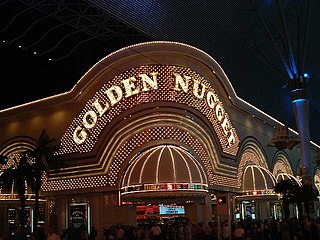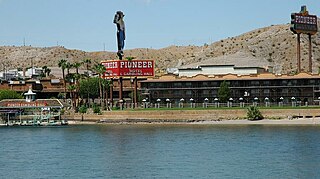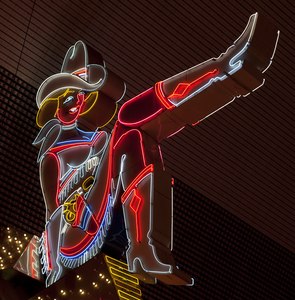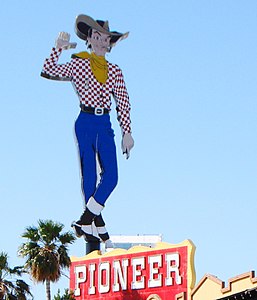
Las Vegas, often known simply as Vegas, is the 25th-most populous city in the United States, the most populous city in the state of Nevada, and the county seat of Clark County. The Las Vegas Valley metropolitan area is the largest within the greater Mojave Desert, and second-largest in the Southwestern United States. Las Vegas is an internationally renowned major resort city, known primarily for its gambling, shopping, fine dining, entertainment, and nightlife, with most venues centered on downtown Las Vegas and more to the Las Vegas Strip just outside city limits. The Las Vegas Valley as a whole serves as the leading financial, commercial, and cultural center for Nevada.

The Golden Nugget Las Vegas is a luxury hotel and casino located in downtown Las Vegas, Nevada on the Fremont Street Experience. The property is owned and operated by Landry's, Inc. It has 2,419 hotel rooms.

The Fremont Street Experience (FSE) is a pedestrian mall and attraction in downtown Las Vegas, Nevada. The FSE occupies the westernmost five blocks of Fremont Street, including the area known for years as "Glitter Gulch", and portions of some other adjacent streets.

The Welcome to Fabulous Las Vegas sign is a Las Vegas landmark funded in May 1959 and erected soon after by Western Neon. The sign was designed by Betty Willis at the request of Ted Rogich, a local salesman, who sold it to Clark County, Nevada.
Las Vegas Boulevard is a major road in Clark County, Nevada, United States, best known for the Las Vegas Strip portion of the road and its casinos. Formerly carrying U.S. Route 91 (US 91), which had been the main highway between Los Angeles, California and Salt Lake City, Utah, it has been bypassed by Interstate 15 and serves mainly local traffic with some sections designated State Route 604.

Downtown Las Vegas is the central business district and historic center of Las Vegas, Nevada, United States. It is the original townsite, and the Downtown gaming area was the primary gambling district of Las Vegas prior to the Strip. As the urban core of the Las Vegas Valley, it features a variety of hotel and business highrises, cultural centers, historical buildings and government institutions, as well as residential and retail developments. Downtown is located in the center of the Las Vegas Valley and just north of the Las Vegas Strip, centered on Fremont Street, the Fremont Street Experience and Fremont East. The city defines the area as bounded by I-15 on the west, Washington Avenue on the north, Maryland Parkway on the east and Sahara Avenue on the south.

The Golden Gate Hotel & Casino is located at One Fremont Street in Las Vegas, Nevada, United States. A part of the Fremont Street Experience, it is the oldest and smallest hotel on the Fremont Street Experience.

Fremont Street is a street in downtown Las Vegas, Nevada that is the second most famous street in the Las Vegas Valley – and Nevada – besides the Las Vegas Strip. Named in honor of explorer and politician John C. Frémont and located in the heart of the downtown casino corridor, Fremont Street is today, or was, the address for many famous casinos such as Binion's Horseshoe, Eldorado Club, Fremont Hotel and Casino, Golden Gate Hotel and Casino, Golden Nugget, Four Queens, The Mint, and the Pioneer Club.

The Four Queens Hotel and Casino is located in downtown Las Vegas on the Fremont Street Experience. The 690-room hotel and 27,269 sq ft (2,533.4 m2) casino is owned and operated by TLC Casino Enterprises, which acquired the property from the Elsinore Corporation in 2003.

The Neon Museum in Las Vegas, Nevada, United States, features signs from old casinos and other businesses displayed outdoors on 2.62 acres (1.06 ha). The museum features a restored lobby shell from the defunct La Concha Motel as its visitors' center, which officially opened on October 27, 2012.

YESCO is a privately owned manufacturer of electric signs based in Salt Lake City, founded by Thomas Young in 1920. The company provides design, fabrication, installation and maintenance of signs.

Las Vegas Club was a hotel and casino located on the Fremont Street Experience in downtown Las Vegas, Nevada. The Las Vegas Club opened in 1930, joining the Las Vegas Hotel which had opened in 1908. The Las Vegas Club was relocated across the street in 1949. At its new location, the Las Vegas Club operated within the Overland Hotel, which was established in 1905.

Pioneer Hotel & Gambling Hall is a hotel and casino located on the banks of the Colorado River in Laughlin, Nevada. It is known for its neon cigarette-puffing "River Rick" marque. It was a sister property of the Pioneer Club in Las Vegas until both properties were sold to separate parties.

Pioneer Club Las Vegas was a casino that opened in 1942 and was located in Downtown Las Vegas, Nevada, at 25 East Fremont Street. It ceased operating as a casino in 1995, the same year the Fremont Street Experience was completed.

Wendover Will is a sign created for the Stateline Casino in West Wendover, Nevada in 1952. It is now a landmark for the town of West Wendover.
Stateline Hotel and Casino was located in West Wendover straddling the Nevada/Utah border.

La Bayou was a casino located on the Fremont Street Experience in Downtown Las Vegas, Nevada.
Gold Strike Resorts was a family of gaming companies based in Jean, Nevada.

The 1950s was a time of considerable change for Las Vegas. By the 1950s, there were 44,600 living in the Las Vegas Valley. Over 8 million people were visiting Las Vegas annually in 1954, pumping $200 million into casinos, which consolidated its image as "wild, full of late-night, exotic entertainment". The population grew dramatically from 8,422 during World War II to over 45,000. From 1952 to 1957, through money and institutional lending provided by the Teamsters Union and some Mormon bankers, they built the Sahara, the Sands, the New Frontier, the Royal Nevada, the Showboat, the Riviera, the Fremont, Binion's Horseshoe, and finally the Tropicana. Gambling was no longer the only attraction by the 1950s; the biggest stars of films and music like Frank Sinatra, Dean Martin, Sammy Davis, Jr., Peter Lawford, Andy Williams, Liberace, Bing Crosby, Carol Channing, and others performed in intimate settings and brought a whole new brigade of Hollywood film stars and others in the entertainment business to the city. In 1957, the first topless show "Minsky's Follies" was started here.

























